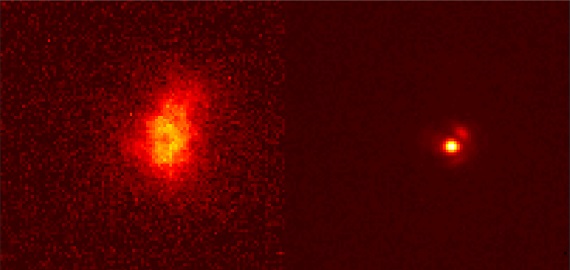After starlight enters the atmosphere, it passes through layers of turbulence that grant the light a twinkling or flickering effect when viewed from Earth. This turbulence also affects the quality of images taken with ground telescopes. This effect can be mitigated with adaptive optics, which serve to correct the distortion caused by atmospheric turbulence.
For this reason, images taken with space telescopes hold a significant advantage over those taken with ground-based systems. Now, an adaptive optics system being developed by the National Research Council of Canada (NRC) aims to enable the capture of images that are comparable in quality, and far less expensive, than those taken with space telescopes.
The system, which is under development at the NRC’s Herzberg Astronomy and Astrophysics Research Centre in Victoria, British Columbia, is called Research, Experiment, and Validation of Adaptive Optics with a Legacy Telescope (REVOLT). It uses a combination of advanced cameras, bendable mirrors, and high-speed computers to correct the effects of atmospheric disturbances on image quality and resolution. It includes two new technologies: a commercial, high-speed camera called C-Blue One and the Herzberg Extensible Adaptive Real-Time Toolkit (HEART).

Images of the star Alpha Persei. The image on the left shows what the star looks like without using REVOLT. The image on the right shows what the star looks like when REVOLT is used. REVOLT improved the resolution of the image by a factor of five and the sensitivity by a factor of almost 500. Courtesy of National Research Council of Canada.
REVOLT will provide a testing ground for larger optical telescopes now in place, up to 10 m, and in development, up to 39 m. “Time on these big telescopes around the world is in very high demand, so when they acquire new technology, they want proof that it has a very high level of maturity,” said Jean-Pierre Véran, Adaptive Optics team leader. “REVOLT serves as a test bench that allows us to validate new technologies on a small telescope in operational conditions.”
The system, which took about two years to complete, was successfully tested on the McKellar Telescope for the first time in August 2022.
Kathryn Jackson, Adaptive Optics scientist at the Herzberg Astronomy and Astrophysics Research Centre, said, “This means we can see an object almost 500 times fainter with the same amount of observing time, which is an illustration of one of the key benefits of Adaptive Optics for large research telescopes.”
The results showed that REVOLT efficiently corrected atmospheric turbulence affecting image quality, and that HEART and the C-Blue One camera — a CMOS, low-noise, digital camera that takes 1000 high-resolution images per second — performed as expected when tested in operational conditions. REVOLT continues to undergo testing on the 1.2-m McKellar Telescope in British Columbia.
The REVOLT experiment was the first time C-Blue One was used in an AO system on a telescope observing actual astronomical objects.
HEART’s first client, the Gemini North Observatory in Hawaii, had the researchers work with the Gemini North Adaptive Optics (GNAO) imager to fix the twinkling effect present in the observatory’s massive telescope. The GNAO’s RTC is based on HEART, created by the research center’s multidisciplinary team. HEART’s layout, architecture, and tools enable REVOLT to adjust to and drive adaptive optics. The GNAO RTC acts as the brain of the system, processing incoming natural and laser-guided star sensor signals and issuing commands to deformable mirrors.
According to Jennifer Dunn, head of the Herzberg Astronomy and Astrophysics Research Centre Software Group, once the system is installed, it will significantly increase the scientific productivity of Gemini.
The REVOLT team plans to help other NRC research centers who want to use the testbed. In the future, HEART will be deployed on adaptive optics systems in observatories around the world.
Additional plans for REVOLT include using it to feed corrected starlight into an optical fiber to enable an on-sky demonstration of a novel fiber-fed prototype device called a spectral correlation sensor. This sensor, jointly developed by the Herzberg Astronomy and Astrophysics and Advanced Electronics and Photonics research centers, uses silicon photonics chip technology to produce an ultracompact, lightweight, astronomical instrument for high-sensitivity, real-time, remote gas detection in stellar and planetary atmospheres. The demo will be the first field test of the spectral correlation sensor using a professional-grade telescope under real-world operating conditions.
Further, a new generation of low-voltage deformable mirrors (LVDMs) will be tested on REVOLT. LVDMs can correct images from land-based telescopes and ground-to-space communications waves that have been distorted due to turbulence in the atmosphere. LVDM is key to integrating various components of a micro-electro-mechanical system deformable mirror, including the mirror face sheet, the electromagnetic actuator, the circuits on a semiconductor wafer, and the printed circuit board, all due to the low driving voltage utilized by the electromagnetic force from a powerful permanent magnet. The new generation of LDVMs will offer low power consumption, high mirror displacement, high fill factor of the reflective deformable mirror surface, and a 1-ms response time — properties that will help to compensate for atmospheric turbulence in real time.